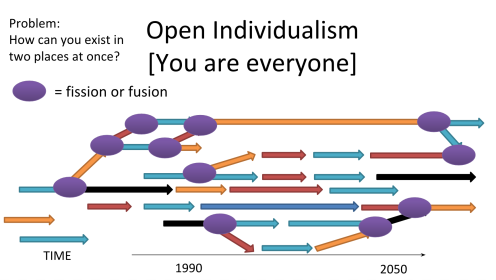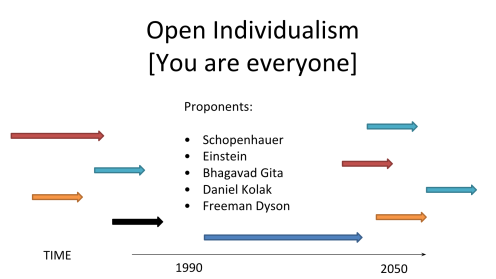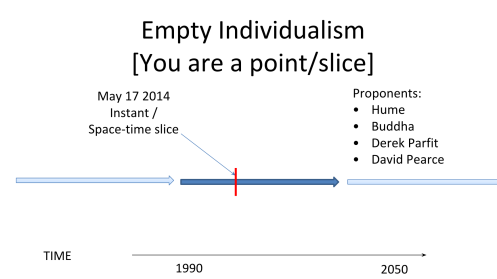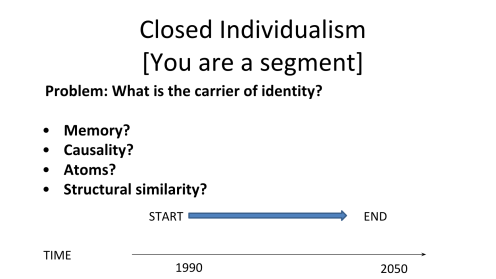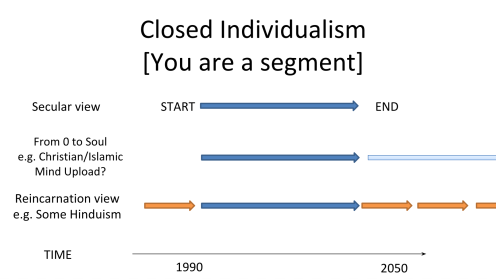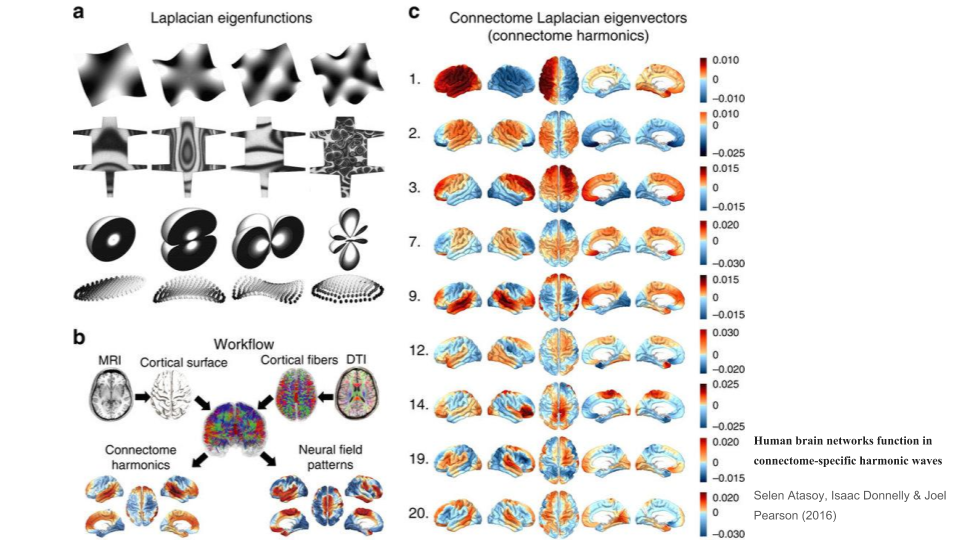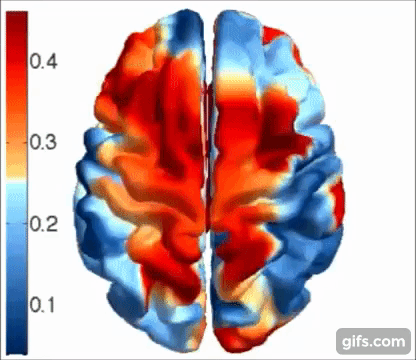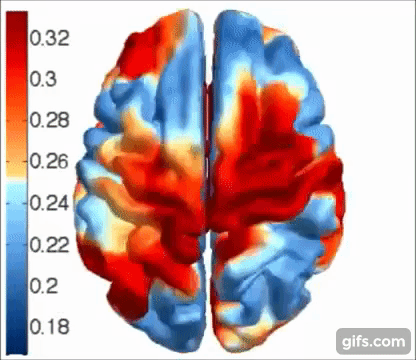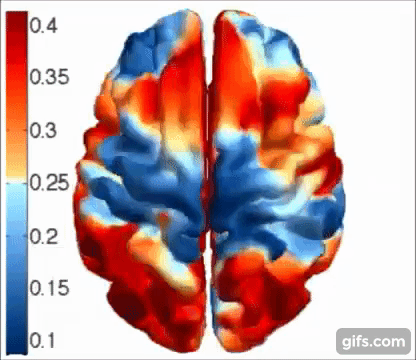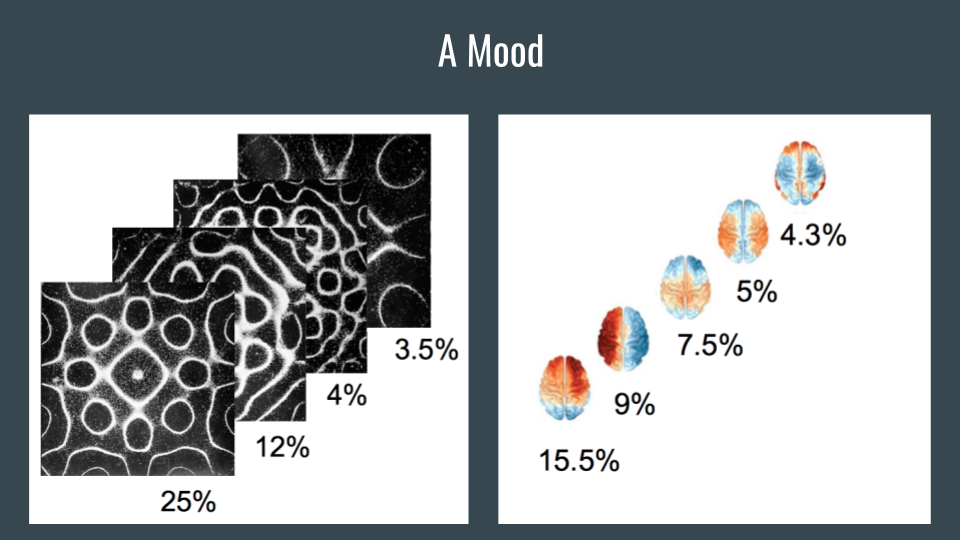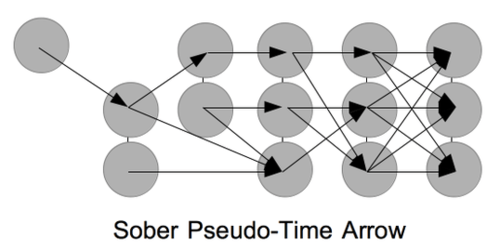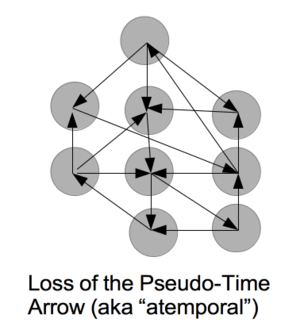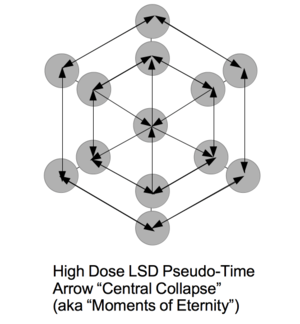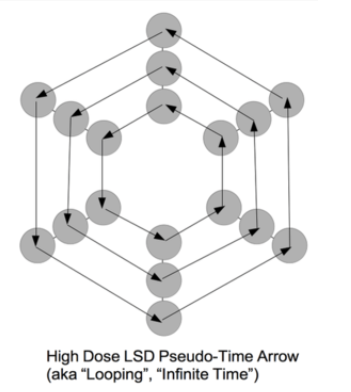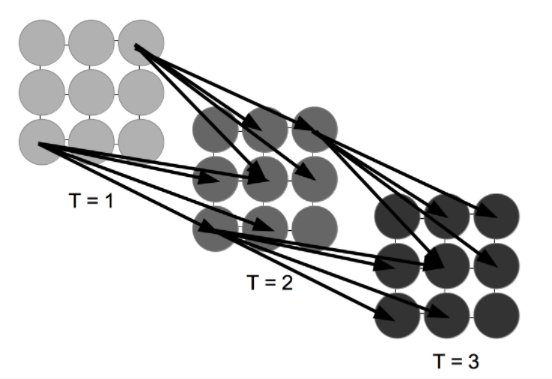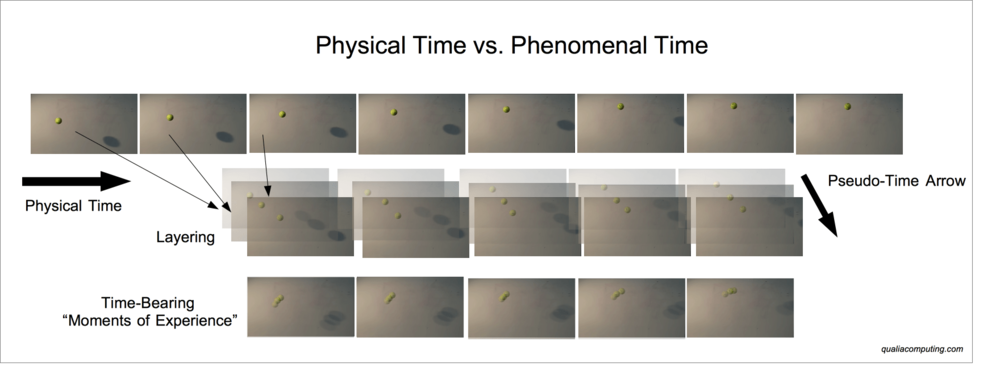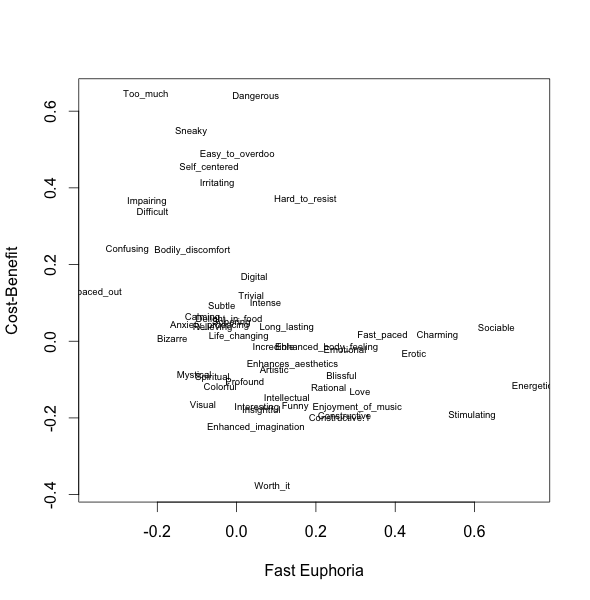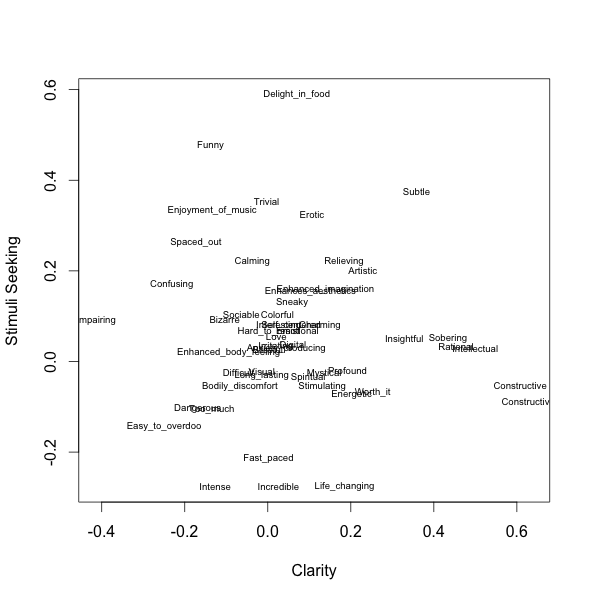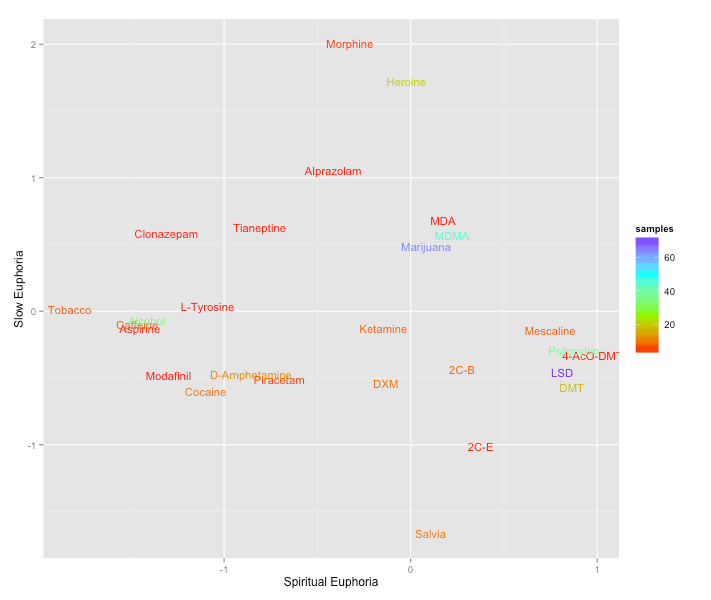Basics
There are over a dozen common uses for the word consciousness, and all of them are interesting. Common senses include: self-awareness, linguistic cognition, and the ability to navigate one’s environment. With that said, the sense of the word in the context of QRI is more often than not: the very fact of experience, that experience exists and there is something that it feels like to be. Talking loosely and evocatively—rather than formally and precisely—consciousness refers to “what experience is made of”. Of course formalizing that statement requires a lot of unpacking about the nature of matter, time, selfhood, and so on. But this is a start.
This word refers to the range of ways in which experience presents itself. Experiences can be richly colored or bare and monochromatic, they can be spatial and kinesthetic or devoid of geometry and directions, they can be flavorfully blended or felt as coming from mutually unintelligible dimensions, and so on. Classic qualia examples include things like the redness of red, the tartness of lime, and the glow of bodily warmth. However, qualia extends into categories far beyond the classic examples, beyond the wildest of our common-sense conceptions. There are modes of experience as altogether different from everything we have ever experienced as vision qualia is different from sound qualia.
How good or bad an experience feels – each experience expresses a balance between positive, neutral, and negative notes. The aspect of experience that accounts for its pleasant and unpleasant qualities. The term is evocative of pleasant sensations such as warming up one’s body when cold with a blanket and a cup of hot chocolate. That said, hedonic tone refers to a much broader class of sensations than just the feeling of warmth. For example, the music appreciation enhancement produced by drugs can be described as “enhanced hedonic tone in sound qualia”. Hedonic tone can appear in any sensory modality (touch, smell, sight, etc.), and even more generally, in every facet of experience (such as cognitive and proprioceptive elements, themselves capable of coming with their own flavor of euphoria/dysphoria). Experiences with both negative and positive notes are called “mixed”, which are the most common ones.
Helpful Philosophy
At the most basic level, an ontology is an account of what is real and what exists.
The set of strategies, heuristics, and methods for knowing. In the context of consciousness research, what constitutes a good epistemology is a highly contentious subject. Some scientists argue that we should only take into account objectively-measurable third-person data in order to build models and postulate theories about consciousness (cf. heterophenomenology). On the other extreme, some argue that the only information that counts is first-person experiences and what they reveal to us (cf. new mysterianism). Somewhere in the middle, QRI fully embraces objective third-person data. And along with it, QRI recognizes the importance of skepticism and epistemic rigor when it comes to which first-person accounts should be taken seriously. Its epistemology does accept the information gained from alien state-spaces of consciousness as long as they meet some criteria. For example, we are very careful to distinguish between information about the intentional content of experience (what it was about) and information about its phenomenal character (how it felt). As a general heuristic, QRI tends to value more e.g. trip reports that emphasize the phenomenal character of the experience (e.g. “30Hz flashes with slow-decay harmonic reverb audio hallucinations”) relative to intentional content (e.g. “the DMT alien said I should learn to play the guitar”). Ultimately, first-person and third-person data are complementary views of the same substrate of consciousness (cf. dual-aspect monism), and so are both equally necessary for a complete scientific account of consciousness.
In Philosophy of Mind, functionalism is the view that consciousness is produced (and in some cases identical with) not only by the input-output mapping of an information-processing system, but also by the internal relationships that make that information-processing possible. In light of Marr’s Levels of Analysis (see below), we could say that functionalism identifies the content of conscious experience with the algorithmic level of analysis. Hence this philosophy is usually presented in conjunction with the concept of “substrate neutrality” which posits that the material makeup of brains is not necessary for the arising of consciousness out of it. If we implemented the same information-processing functions that are encoded in the neural networks of a brain using rocks, buckets of water, or a large crowd instantiating a large computer, we would also generate the same experiences the brain generates on its own. Importantly, functionalism tends to deny any essential role of the substrate in the generation of consciousness, and will typically also deny any significant interaction between levels of analysis (see below).
In Philosophy of Mind, eliminativism refers to a cluster of ideas concerning whether the word “consciousness” is clear enough to be useful for making sense of how brains work. One key idea in eliminativist views is that most of the language that we use to talk about experiences (from specific emotions to qualia) is built on top of folk-psychology rather than physical reality. In a way, terms such as “experience” and “feelings” are an interface for the brain to model itself and others in a massively simplified but adaptive way. There is no reason why our evolved intuitions about how the brain works should even approximate how it really works. In many cases, eliminativists advocate starting from scratch and abandoning our intuitions about experience, sticking to hard physical and computational analysis of the brain as empirically measured. This view suggests that once we truly understand scientifically how brains work, the language we will use to talk about it will look nothing like the way we currently speak about our experiences, and that this change will be so dramatic that we would effectively start thinking as if “consciousness never existed to begin with”.
The view that only the present is real, the past and the future being illusory inferences and projections made in the present. Oftentimes presentism posits that change is a fundamental aspect of the present and that the feeling of the passage of time is based on the ever-changing nature of reality itself.
The view that every here-and-now in reality is equally real. Rather than thinking of the universe as a “now” sandwiched between a “past” and “future”, eternalism posits that it is more accurate to simply describe pairs of moments as having a “before” and “after” relationship, but neither of them being in the future or past. Some of the strongest arguments for eternalism come from Special and General Relativity (see: Rietdijk–Putnam argument), where space-time forms a continuous 4-dimensional geometric shape that stands together as a whole, and where any notion of a “present” is only locally valid. In some sense, eternalism says that all of reality exists in an “eternal now” (including your present, past, and future selves).
The relevant sense of this term for our purposes refers to the set of questions about what constitutes the natural unit for subjects of experience. Questions such as “will the consciousness who wakes up in my current body tomorrow morning be me?”, “if we make an atom-by-atom identical copy of me right now, will I start existing in it as well?”, “if you conduct a Wada Test, is the consciousness generated by my right hemisphere alone also me?”, and so on.
In its most basic form, this is the common-sense personal identity view that you start existing when you are born and stop existing when you die. According to this view each person is a different subject of experience with an independent existence. One can believe in a soul ontology and be a Closed Individualist at the same time, with the correction that you exist as long as your soul exists, which could be the case even before or after death.
This personal identity view states that each “moment of experience” is its own separate subject. While it may seem that we exist as persons with an existence that spans decades, Empty Individualism does not associate a single subject to each person. Rather, each moment a new “self” is born and dies, existing for as long as the conscious event takes place (something that could be anywhere between a femtosecond and a few hundred milliseconds, depending on which scientific theory of consciousness one believes in).
This is the personal identity view that we are all one single consciousness. The apparent partitions and separations between the universal consciousness, in this view, are the result of partial information access from one moment of experience to the next. Regardless, the subject who gets to experience every moment is the same. Each sentient being is fundamentally part of the same universal subject of experience.
Having realized that there are both positive and negative psychological aspects to each of the three views of personal identity discussed (Closed, Empty, Open Individualism), the Goldilocks Zone of Oneness emerges as a conceptual resolution. Open Individualism comes with a solution to the fear of death, but it also can give rise to a sort of cosmic solipsism. Closed Individualism allows you to feel fundamentally special, but also disconnected from the universe and fundamentally misunderstood by others. Empty Individualism is philosophically satisfying, but it may come with a sense of lack of agency and the fear of being a time-slice that is stuck in a negative place. The Goldilocks Zone of Oneness posits that there is a way to transcend classical logic in personal identity, and that the truth incorporates elements of all of the three views at once. In the Goldilocks Zone of Oneness one is simultaneously part of a whole but also not the entirety of it. One can relate with others by having a shared nature, while also being able to love them on their own terms by recognizing their unique identity. This view has yet to be formalized, but in the meantime it may prove to be pragmatically useful for community-building.
This is the philosophical conundrum of whether other people (and sentient beings in general) are conscious. While your own consciousness is self-evidence, the consciousness of others is inferred. Possible solutions involve technologies such as the Generalized Wada Test (see below), phenomenal puzzles, and thalamic bridges, which you can use to test the consciousness of another being by having it solve a problem that can only be solved by making comparisons between qualia values.
In its classic formulation, solipsism refers to a state of existence in which the only person who is conscious is “oneself”, which resides in the body of an individual human over time. A more general version of solipsism involves crossing it with personal identity views (see above). Through this lens, the classic person-centric formulation of solipsism refers exclusively to a Closed Individualist universe. Alternatively, Open Individualism also has a solipsistic interpretation – it is thus compatible with (and in at least in one sense entails) solipsism: the entire multiverse of experiences are all experiences of a single solipsistic cosmic consciousness. With an Empty Individualist universe, too, we can have a solipsistic interpretation of reality. In one version you use epiphenomenalism to claim that this moment of experience is the only one that is conscious even though the whole universe still exists and it had an evolutionary path that led it to the configuration in which you stand right now. In another version, one’s experience is the result of the fact that in the cosmic void everything can happen. This is not because it is likely, but because there is a boundless amount of time for it to happen. That is, no matter how thin its probability is, it will still take place at some point (see: Boltzmann brain). That said, one’s present experience -with its highly specific information content- being the only one that exists seems very improbable a priori. Like imagining that despite the fact that “the void can give rise to anything” the only thing that actually gets materialized is an elephant. Why would it only produce an elephant, of all things? Likewise, solipsistic Empty Individualism has this problem – why would this experience be the only one? To cap it off, we can also reason about solipsism in its relation to hybrid views of personal identity. In their case solipsism either fails, or its formulation needs to be complicated significantly. This is partly why the concept of the Goldilocks Zone of Oneness (see above) might be worth exploring, as it may be a way out of ultimate solipsism. On a much more proximal domain, it may be possible to use Phenomenal Puzzles, Wada tests, and ultimately mindmelding to test the classical (Closed Individualist) formulation of solipsism.
The view that our overriding obligation is to focus on suffering. In particular, taking seriously the prevention of extreme suffering is one of the features of this view. This is not unreasonable if we take into account the logarithmic scales of pain and pleasure into account, which suggest that the majority of suffering is concentrated in a small percent of experiences of intense suffering. Hence why caring about the extreme cases matters so much.
This is the view that being born entails a net negative. Classic formulations of this view tend to implicitly assume Closed Individualism, where there is someone who may or may not be born and it is meaningful to consider this a yes or no question with ontological bearings. Under Open Individualism the question becomes whether there should be any conscious being at all, for neither preventing someone’s birth nor committing an individual suicide entail the real birth or death of a consciousness. They would merely add or subtract from the long library corridors of experiences had by universal consciousness. And in Empty Individualism, antinatalism might be seen through the light of “preventing specific experiences with certain qualities”. For example, having an experience of extreme suffering is not harming a person (though it may have further psychological repercussions), but rather harming that very experience in an intrinsic way. This view would underscore the importance of preventing the existence of experiences of intense suffering rather than preventing the existence of people as such. A final note on antinalism is that even in its original formulation we encounter the problem that selection pressures makes any trait that reduces inclusive fitness disappear in the long run. The traits that predispose to such views would simply be selected out. A more fruitful way of improving the world is to encourage the elimination of suffering in ways that do not reduce inclusive fitness, such as the prevention of genetic spell errors and diseases that carry a high burden of suffering.
The way our reward architecture is constructed makes it difficult for us to have a clear sense of what it is that we enjoy about life. Our brains reinforce the pursuit of specific objects, situations, and headspaces, which gives the impression that these are intrinsically valuable. But this is an illusion. In reality such conditions trigger positive valence changes to our experience, and it is those that we are really after (as evidenced by the way in which our reward architecture is modified in presence of euphoric and dysphoric drugs and external stimuli such as music). We call this illusion the tyranny of the intentional object because in philosophy “intentionality” refers to “what the experience is about”. Our world-simulations chain us to the feeling that external objects, circumstances, and headspaces are the very source of value. More so, dissociating from such sources of positive valence triggers negative valence, so critical insight into the way our reward architecture really works is itself negatively reinforced by it.
Formalism Terms
Formalism is a philosophical and methodological approach for analyzing systems which postulates the existence of mathematical objects such that their mathematical features are isomorphic to the properties of the system. An example of a successful formalism is the use of Maxwell’s equations in order to describe electromagnetic phenomena.
Qualia Formalism means that for any given physical system that is conscious, there will be a corresponding mathematical object associated to it such that the mathematical features of that object will be isomorphic to the phenomenology of the experience generated by the system.
This powerful analytic framework was developed by cognitive scientist David Marr to talk more precisely about vision, but it is more broadly applicable to information processing systems in general. It is a way to break down what a system does in a conceptually clear fashion that lends itself to a clean analysis.
The first of three of Marr’s Levels of Analysis, the Computational Level of abstraction describes what the system does from a third-person point of view. That is, the input-output mapping, the runtime complexity for the problems it can solve, and the ways in which it fails are all facts about a system that are at the computational level of abstraction. In a simple example case, we can describe an abacus at the computational level by saying that it can do sums, subtractions, multiplications, divisions, and other arithmetic operations.
The second of three of Marr’s Levels of Analysis, the Algorithmic Level of abstraction describes the internal representations, operations, and their interactions used to transform the input into the output. In aggregate, representations, operations, and their interactions constitute the algorithms of the system. As a general rule, we find that there are many possible algorithms that give rise to the same computational-level properties. Following the simple example case of an abacus, the algorithmic-level account would describe how passing beads from one side to another and using each row to represent different orders of magnitude are used to instantiate algorithms to perform arithmetic operations.
The third of three of Marr’s Levels of Analysis, the Implementation Level of abstraction describes the way in which the system’s algorithms are physically instantiated. Following the case of the abacus, an implementation-level account would detail how the various materials of the abacus are put together in order to allow the smooth passing of beads between the sides of each row and how to prevent them from sliding by accident (and “forgetting” the state).
Some information-processing systems can be fully understood by describing each of Marr’s Levels of Analysis separately. For example, it does not matter whether an abacus is made of metal, wood, or even if it is digitally simulated in order to explain its algorithmic and computational-level properties. But while this is true for an abacus, it is not the case for analog systems that leverage the unique physical properties of their components to do computational shortcuts. In particular, in quantum computing one intrinsically requires an understanding of the implementation-level properties of the system in order to explain the algorithms used. Hence, for quantum computing, there are strong interactions between levels of analysis. Likewise, we believe this is likely going to be the case for the algorithms our brains perform by leveraging the unique properties of qualia.
Natural kinds are things whose objective existence makes it possible to discover durable facts about them. They are the elements of a “true ontology” for the universe, and what “carves reality at its joints”. This is in contrast to “reifications” which are aggregates of elements with no unitary independent existence.
A state-space of a system is a geometric map where each point corresponds to a particular state of the system. Usually the space has a Euclidean geometry with a number of dimensions equal to the number of variables in the system, so that the value of each variable is encoded in the value of a corresponding dimension. This is not always the case, however. In the general case, not all points in the state-space are physically realizable. Additionally, some system configurations do not admit a natural decomposition into a constant set of variables. This may give rise to irregularities in the state-space, such as non-Euclidean regions or a variable number of dimensions.
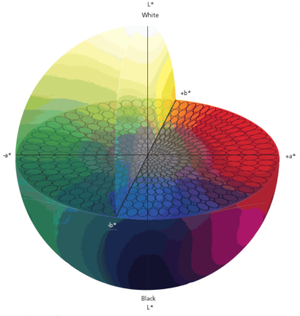
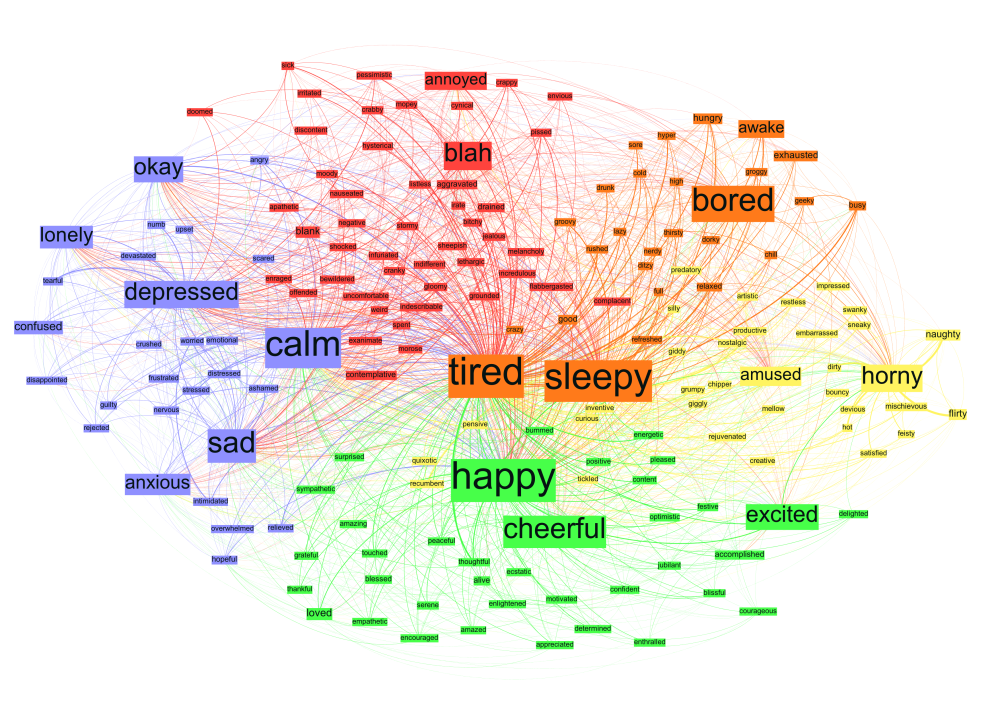
This is a hypothetical map that contains the set of all possible experiences, organized in such a way that the similarities between experiences are encoded in the geometry of the state-space. For example, the experience you are having right now would correspond to a single point in the state-space of consciousness, with the neighboring experiences being Just Noticeably Different from your experience right now (e.g. simplistically, we could say they would be different from your current experience “by a single pixel”).
Starting with examples— the scent of cinnamon, a spark of sourness, a specific color hue, etc. are all qualia values. Any particular quality of experience that cannot be decomposed further into overlapping components is a qualia value.
A qualia variety refers to the set of qualia values that belong to the same category (for example, tentatively, phenomenal colors are all part of the same qualia variety, which is different from the qualia variety of phenomenal sounds). A possible operationalization for qualia varieties involves the construction of equivalence classes based on the ability to transform a given qualia value into another via a series of Just-Noticeable Differences. For example, in the case of color, we can transform a given qualia value like a specific shade of blue, into another qualia value like a shade of green by traversing across a straight line from one to the other in the CIELAB color space. Tentatively, it is not possible to do the same between a shade of blue and a particular phenomenal sound. That said, the large number of unknowns (and unknown unknowns!) about the state-space of consciousness does not allow us to rule out the existence of qualia values that can bridge the gap between color and sound qualia. If that turned out to be the case, we would need to rethink our approach to defining qualia varieties.
A set of possible experiences that are similar to each other in some way. Given an experience, the “experiences nearby in the state-space of consciousness” are those that share its qualities to a large degree but have variations. The term can be used to point at experiences with a given property (such as “high-valence” and “phenomenal color”).
The binding problem (also called the combination problem) arises from asking the question: how is it possible that the activity of a hundred billion neurons that are spatially distributed can simultaneously contribute to a unitary moment of experience? It should be noted that in the classical formulation of the problem we start with an “atomistic” ontology where the universe is made of space, particles, and forces, and the question then becomes how spatially-distributed discrete particles can “collaborate” to form a unified experience. But if one starts out with a “globalistic” ontology where the universe is made of a universal wavefunction, then the question that arises is how something that is fundamentally unitary (the whole universe) can give rise to “separate parts” such as individual experiences, which is often called “the boundary problem”. Thus, the “binding problem” and “the boundary problem” are really the same problem, but starting with different ontologies (atomistic vs. globalistic).
This term refers to the hypothetical mechanism of action that enables information that is spatially-distributed across a brain (and more generally, a conscious system) to simultaneously contribute to a unitary discrete moment of experience.
Local binding refers to the way in which the features of our experience are interrelated. Imagine you are looking at a sheet of paper with a drawing of a blue square and a yellow triangle. If your visual system works well you do not question which shape is colored blue; the color and the shapes come unified within one’s experience. In this case, we would say that color qualia and shape qualia are locally bound. Disorders of perception show that this is not always the case: people with simultagnosia find it hard to perceive more than one phenomenal object at a time and thus would confuse the association between the colors and shapes they are not directly attending to, people with schizophrenia have local binding problems in the construction of their sense of self, and people with motion blindness have a failure of local binding between sensory stimuli separated by physical time.
Global binding refers to the fact that the entirety of the contents of each experience is simultaneously apprehended by a unitary experiential self. As in the example for local binding, while blue and the square (and the yellow and the triangle) are locally bound into separate phenomenal objects, both the blue square and the yellow triangle are globally bound into the same experience.
The Mathematics of Valence
This is the claim that valence is a crisp phenomenon of conscious states upon which we can apply a measure. Also defined as: “Valence (subjective pleasantness) is a well-defined and ordered property of conscious systems.”
Valence could have a simple encoding in the mathematical representation of a system’s qualia.

Given a mathematical object isomorphic to the qualia of a system, the mathematical property which corresponds to how pleasant it is to be that system is that object’s symmetry.
It is postulated that one of the important inputs that contributes to our decision-making involves “valence gradients”. To understand what a valence gradient is, it is helpful to provide an example. Imagine coming back from dancing in the rain and feeling pretty cold. In order to warm yourself up you get into the shower and turn on the hot water. Ouch! Too hot, so you dial down the temperature. Brrr! Now it’s too cold, so you dial up the temperature just a little. Ah, just perfect! See, during this process you evaluated, at each point, in what way you could modify your experience in order to make it feel better. At first the valence gradient was pointing in the direction of higher temperature. As soon as you felt it being too hot, the valence gradient changed direction and pointed to lower temperature. And so on until it feels like there is nothing else you could do to improve how you feel. In the more general case, we posit that a significant input into our decision-making is the direction of change along which we believe our experience would improve. At an implementation level of analysis (see above) the very syntax of our experience might be built with a landscape of valence gradients. In a sense, noticing them is possible, but it is a task akin to the metaphor of a fish not knowing what water is. We use valence gradients to navigate both the external and internal world in such a basic and all-pervasive way that missing this fact altogether is easy. When we justify why we did such and such, we often forget that a big component of the decision was made based on how each of the options felt. The difficulty we face when trying to point at the specific valence gradients that influence our decision-making is one of the reasons why the tyranny of the intentional object (see above) arises, which is that what pulls and pushes us is not explicitly represented in our conceptual scheme.
A scientific and philosophical hypothesis with implications for measuring valence in conscious systems. Namely, the hypothesis is that the Symmetry Theory of Valence is expressed in the structure of neural patterns over time, implying that the valence of a brain will be in part determined by neural dissonance, consonance, and noise. This makes precise, empirically testable predictions within paradigms such as Connectome-Specific Harmonic Waves.
The sum total of the intensity-weighted qualia in an experience. For example, it is noted that on DMT many energy invariants get activated: intense color can morph into acceleration which can morph into curvature and so on, as if they were trading a common currency (a unified “energy of consciousness” property).
Research Paradigms
Evolutionary Qualia is a scientific discipline that will emerge as the science of consciousness improves to the point where cellular gene expression analysis, brain imaging, and interpretation algorithms get to infer the qualia present in the experience of the brains of animals in general. For instance, we may find out that certain combinations of receptor types and protein shapes inside neurons of the visual cortex are necessary and sufficient for generating color qualia. Additionally, such understanding could be complemented with an information-theoretic account of why color qualia is more effective (cost-benefit-wise) for certain information-processing than other qualia. Together, these two kinds of understanding will allow us to explain why the specific qualia that we have was recruited by natural selection for information-processing purposes. Evolutionary Qualia is the (future) discipline that explains from an evolutionary point of view why we have the specific qualia and patterns of local binding that we do (said differently, it will explain why “the walls of our world-simulation are painted the way they are”). So while Evolutionary Psychology may explain why we have evolved to have some emotions from the point of view of their behavioral effects, Evolutionary Qualia will explain why the emotions feel the way they do and how those specific feelings happen to have the right “shape” for the information-processing tasks they accomplish.
A reduction is a model that explains a set of behaviors, often very complex and diverse, in terms of the interaction between variables. A successful reduction is one that explains the intricacies and complexities present in the set of behaviors as emergent effects from a much smaller number of variables and their interactions. A specific case is that of “atomistic reductions” which decompose a set of behaviors in terms of particles interacting with each other (e.g. ideal gas laws from statistical mechanics in physics). While many scientifically significant reductions are atomistic in nature, one should not think that every phenomenon can be successfully reduced atomistically (e.g. double-slit experiment). Even when a set of behaviors cannot be reduced atomistically we may be able to algorithmically reduce it. That is, to identify a set of processes, internal representations, and interactions that when combined give rise to the set of observed behaviors. This style of reduction is very useful in the field of phenomenology since it can provide insights into how complex phenomena (such as psychedelic hallucinations) emerge out of a few relatively simple algorithmic building blocks. This way we avoid begging the question by not assuming an atomistic ontology in a context where it is not clear what atoms correspond to.


Encoding information in videos, text, abstract paintings, etc. such that only people who are in a specific state of consciousness can decode it. A simple example is the use of alternations in after-image formation on psychedelics (enhanced persistence of vision, aka. tracers) to paint a picture by presenting the content of an image one column of pixels at a time. Sober individuals only see a column of pixels while people high on psychedelics will see a long trace forming parts of an image that can be inferred by paying close attention. In general, psychedelic cryptography can be done by taking advantage of any of the algorithms one finds with algorithmic reductions of arbitrary states of consciousness. In the case of psychedelics, important effects that can be leveraged include tracers, pareidolia, drifting, and symmetrification.
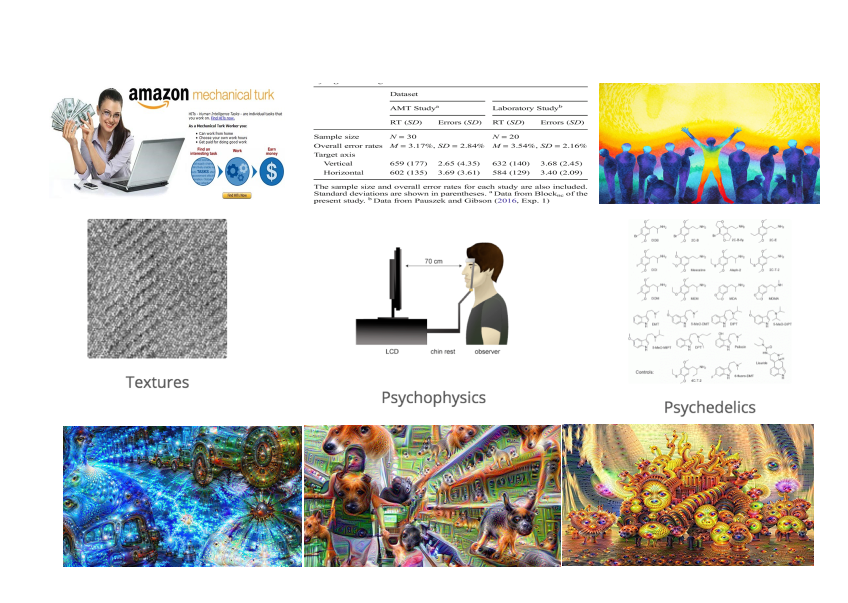
This is a generalization of the Wada Test where rather than pentobarbital being injected in just one hemisphere while the other hemisphere is kept sober, one injects substance A in one hemisphere and substance B on the other. This could be used to improve our epistemology about various states of consciousness. By keeping one hemisphere in a state with robust linguistic ability the other hemisphere could be used to explore alien-state spaces of consciousness and allow for real-time verbal interpretation. The caveats and complications are myriad, but the general direction this concept handle is pointing to is worth exploring.
Phenomenology
The uncertainty that one has about who and where one is. This is relevant in light of states of consciousness that are common on high-dose psychedelics, mental illnesses, and meditation, where the information about one’s identity and one’s place in the world is temporarily inaccessible. Very high- and low-valence states tend to induce a high level of self-locating uncertainty as the information content of the experience is over-written by very simple patterns that dominate one’s attention. Learning to navigate states with self-locating uncertainty without freaking out is a prerequisite for studying alien state-spaces of consciousness.
The felt-sense of the passage of time. This is in contrast to the physical passage of time. Although physical time and phenomenal time tend to be intimately correlated, as you will see in the definition of “exotic phenomenal time” this is not always the case.
The experience of space. Usually our sense of space represents a smooth 3D Euclidean space in a projective fashion (with variable scale encoding subjective distance). In altered states of consciousness phenomenal space can be distorted, expanded, contracted, higher-dimensional, topologically distinct, and even geometrically modified as in the case of hyperbolic geometry while on DMT (see below).
This is a formal model of phenomenal time. It utilizes a simple mathematical object: a graph. The nodes of the graph are identified with simple qualia values (such as colors, basic sounds, etc.) and the edges are identified with local binding connections. According to the pseudo-time arrow model, phenomenal time is isomorphic to the patterns of implicit causality in the graph, as derived from patterns of conditional statistical independence.
It is commonly acknowledged that in some situations time can feel like it is passing faster or slower than normal (cf. tachypsychia). What is less generally known is that experiences of time can be much more general, such as feeling like time stops entirely or that one is stuck in a loop. These are called exotic phenomenal time experiences, and while not very common, they certainly are informative about what phenomenal time is. Deviations from an apparent universal pattern are usually scientifically significant.
This is a variant of exotic phenomenal time in which experience seems to be moving backwards in time. “Inverted tracers” are experienced where one first experiences the faint after-images of objects before they fade in, constitute themselves, and then quickly disappear without a trace. According to the pseudo-time arrow model this experience can be described as an inversion of the implicit arrow of causality, though how this arises dynamically is still a mystery.
This exotic phenomenal time describes experiences where all apparent temporal movement seems to stop. One’s experience seems to have an unchanging quality and there is no way to tell if there will ever be something else other than the present experience in the whole of existence. In most cases this state is accompanied by intense emotions of simple texture and immediacy (rather than complex layered constructions of feelings). The experience seems to appear as the end-point and local maxima of annealing on psychedelic and dissociative states. That is, it often comes as metastable “flashes of large-scale synchrony” that are created over the course of seconds to minutes and decay just as quickly. Significantly, sensory deprivation conditions are ideal for the generation of this particular exotic phenomenal time.
Timelessness is a variant of exotic phenomenal time where causality flows in a very chaotic way at all scales. This prevents forming a general global direction for time. In the state, change is perceptible and it is happening everywhere in your experience, and yet it seems as if there is no consensus among the different parts of your experience about the direction of time. That is, there is no general direction along which the experience seems to be changing as a whole over time. The chaotic bustle of changes that make up the texture of the experience are devoid of a story arc, and yet remain alive and turbulent. Trip reports suggest that the state that arises at the transition points between dissociative plateaus has this noisy timelessness quality (e.g. coming up on ketamine). Listening to green noise evokes the general idea, but you need to imagine that happening on every sensory modality and not just audio.
This is perhaps the most common exotic phenomenal time experience that people have on psychedelics and dissociatives. This is due to the fact that, while it can be generated spontaneously, it is relatively easy to trigger by listening to repetitive music (e.g. a lot of EDM, trance, progressive rock, etc.), repetitive movements (e.g. walking, dancing), and repetitive thoughts (e.g. talking about the same topic for a long time) all of which are often abundant in the set and setting of psychedelic users. The effect happens when your projections about the future and the past are entirely informed by what seems like an endlessly repeating loop of experience. This often comes with intense emotions of its own (which are unusual and outside of the normal range of human experience), but it also triggers secondary emotions (which are just normal emotions amplified) such as fear and worry, or at times wonder and bliss. The pseudo-time arrow model of phenomenal time describes this experience as a graph in which the local patterns of implicit causality form a cycle at the global scale. Thus the phenomenal past and future merge at their tails and one inhabits an experiential world that seems to be infinitely-repeating.
A rare variant of exotic phenomenal time in which you feel like you are able to experience more than one outcome out of events that you witness. Your friend stands up to go to the bathroom. Midway there he wonders whether to go for a snack first, and you see “both possibilities play out at once in superposition”. In an extreme version of this experience type, each event seems to lead to dozens if not hundreds of possible outcomes at once, and your mind becomes like a choose-your-own-adventure book with a broccoli-like branching of narratives, and at the limit all things of all imaginable possible timelines seem to happen at once and you converge on a moment of eternity, thus transitioning out of this variety. We would like to note that a Qualia Computing article delved into the question of how to test if the effect actually allows you to see alternative branches of the multiverse. The author never considered this hypothesis plausible, but the relative ease of testing it made it an interesting, if wacky, research lead. The test consisted of trying to tell apart the difference between a classical and a quantum random number generator in real time. The results of the experiment are all null for the time being.
We represent modal and amodal information in our experience in a projective way. In most common cases, this information forms a 2D “sheet” that encodes the distance to the objects around you, which can be used as a depth-map to navigate your surroundings. A lot of the information we experience is in the combination of this sheet and phenomenal time (i.e. how it changes over time).
The local curvature of the world-sheet encodes a lot of information about the scene. There is a sense in which the “energy” of the experience is related to the curvature of the world-sheet (in addition to its phenomenal richness and brightness). So when one raises the energy of the state dramatically (e.g. by taking DMT) the world-sheet tends to instantiate configurations with very high-curvature. The surface becomes generically hyperbolic, which profoundly alters the overall geometry of one’s experience. A lot of the accounts of “space expansion” on psychedelics can be described in terms of alterations to the geometry of the world-sheet.
A generative definition for the dimensionality of a moment of experience can be “the highest virtual dimension implied by the network of correlations between globally bound degrees of freedom”. Admittedly, at the moment this is more of an intuition pump than a precise formalism, but a number of related phenomena suggest there is something in this general direction. For starters, differences between degrees of pain and pleasure are often described in terms of qualitative changes with phase transitions between them. Likewise, one generally experiences a higher degree of emotional involvement in a given stimuli the more sensory channels one is utilizing to interact with it. Pleasure that has cognitive, emotional, and physical components in a coordinated fashion is felt as much more profound and significant than pleasure that only involves one of those “channels”, or even pleasure that involves all three but where they lack coherence between them. Another striking example involves the states of consciousness induced by DMT, in which there are phase-transitions between the levels. These phase transitions seem to involve a change in the dimensional character of the hallucinations: in addition to hyperbolic geometry, DMT geometry involves a wide range of phenomena with virtual dimensions. On lower doses the hallucinations take the shape of 2D symmetrical plane coverings. On higher doses those covers transform into 2.5D wobbly worldsheets, and on higher doses still into 3D symmetrical tessellations and rooms with 4D features. For example, the DMT level above 3D tessellations has its “walls” covered with symmetrical patterns that are correlated with one another in such a way that they generate a “virtual” 4th dimension, itself capable of containing semantic content. We suspect that one of the reasons why MDMA is so uniquely good at healing trauma is that in order to address a high-dimensional pain you need a high-dimensional pleasure to hold space for it. MDMA seems to induce a high-dimensional variety of feelings of wellbeing, which can support and smooth a high-dimensional pain like such as those which underly traumatic memories.
Qualia Futurology
A “meme” is a cultural unit of information capable of being transmitted from one mind to another. Examples of memes include jokes, hat styles, window-dressing color palettes, and superstitions.
A “memeplex” is a set of memes that, when simultaneously present, increase their ability to replicate (i.e. to be spread from one mind to another). Memeplexes do not need to say true things in order to be good at spreading; many strategies exist to motivate humans to share memes and memeplexes, ranging from producing good feelings (e.g. jokes), being threatening (e.g. apostasy), to being salient (e.g. famous people believe in them). A classic example of a memeplex is that of an ideology such as libertarianism, communism, capitalism, etc.
A “full-stack memeplex” is a memeplex that provides an answer to most common human questions. While the scope of a memeplex like “libertarianism” extends across a variety of fields including economics and ethics, it is not a full-stack memeplex because it does not attempt to answer questions such as “why does anything exist?”, “why are the constants of nature the way they are?” and “what happens after we die?”. Religions and some philosophies like existentialism, Buddhism, and the LessWrong Sequences are full-stack memeplexes. We also consider the QRI ecosystem to contain a full-stack memeplex.
The Hedonistic Imperative is a book-length internet manifesto written by David Pearce which outlines how suffering will be eliminated with biotechnology and why our biological descendants are likely to be animated by gradients of information-sensitive bliss.
In the context of transhumanism, Abolitionism refers to the view in ethics that we should eliminate all forms of involuntary suffering both in human and non-human animals alike. The term was coined by David Pearce.
This is one of the main dimensions along which a drug can have effects, roughly described as “high-energy and high-valence” (with high-loading terms including: energetic, charming, stimulating, sociable, erotic, etc.).
This is one of the main dimensions along which a drug can have effects, roughly described as “low-energy and high-valence” (with high-loading terms including: calming, relieving, blissful, loving, etc.).
This is one of the main dimensions along which a drug can have effects, roughly described as “high-significance and high-valence” (with high-loading terms including: incredible, spiritual, mystical, life-changing, interesting, colorful, etc.).


The act of modifying a mind’s reward architecture and hedonic baseline so that it is always generating experiences with a net positive valence (whether or not they are mixed).
Wireheading done in such a way that one can remain rational, economically productive, and ethical. In particular, it entails (1) taking into account neurological negative feedback systems, (2) avoiding reinforcement cycles that narrow one’s behavioral focus, and (3) preventing becoming a pure replicator (see below). A simple proof of concept reward architecture for Wireheading Done Right is to cycle between different kinds of euphoria, each with immediate diminishing returns, and with the ability to make it easier to experience other kinds of euphoria. This would give rise to circadian cycles with stages involving fast, slow, and spiritual/philosophical euphoria at different times. Wireheading Done Right entails never getting stuck while always being in a positive state.
In the context of agents and minds, a Pure Replicator is an intelligence that is indifferent towards the valence of its conscious states and those of others. A Pure Replicator invests all of its energy and resources into surviving and reproducing, even at the cost of continuous suffering to themselves or others. Its main evolutionary advantage is that it does not need to spend any resources making the world a better place.
This is a reframe of the big-picture narrative of the meaning of life in which the ultimate battle is between the act of reproducing for the sake of reproduction and the act of seeking the wellbeing of sentient beings for the sake of conscious value itself.
A Maximum Effector is an entity that uses all of its resources for the task of causing large effects, irrespective of what they may be. There is a sense in which most humans have a Maximum Effector side. Since causing large effects is not easy, one can reason that for evolutionary reasons people find such an ability to be a hard-to-fake signal of fitness. Arrogance and power may not be all that people find attractive, but they do play a role in what makes someone seem sexy to others. Hence why, unfortunately, people research how to cause large effects even if they are harmful to everyone. The idealized version of a Maximum Effector, however, would be exclusively interested in causing large effects to happen rather than doing so as a way to meet an emotional need among others. Although being a Maximum Effector may seem crazy and pointless, they are important to consider in any analysis of the future because the long-tailed nature of large effects suggest that those who specifically seek to cause them are likely to have an impact on reality orders of magnitude higher than the impact of agents who try to simultaneously have both large and good effects.
This is a hypothetical future intellectual society that investigates consciousness empirically. Rather than merely theorizing about it or having people from the general population describe their odd experiences, the Super-Shulgin Academy directly studies the state-space of consciousness by putting the brightest minds on the task. The Super-Shulgin Academy (1) trains high-quality consciousness researchers and psychonauts, (2) investigates the computational trade-offs between different states of consciousness, (3) finds new socially-useful applications for exotic states of consciousness, (4) practices the art and craft of creating ultra-blissful experiences, and (5) develops and maintains a full-stack memeplex that incorporates the latest insights about the state-space of consciousness into the most up-to-date Theory of Everything.
